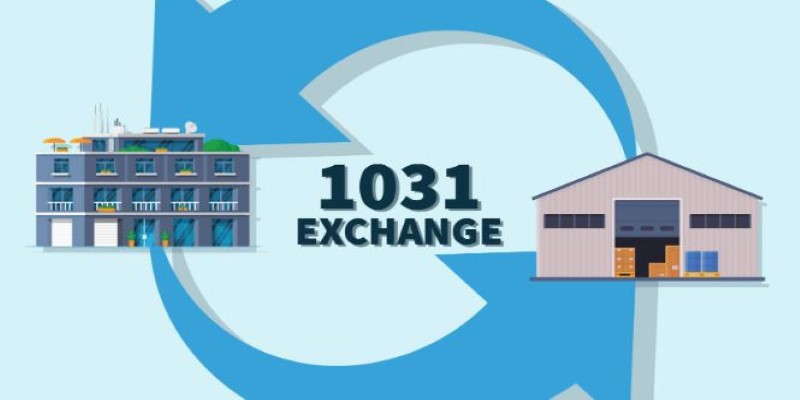How to Leverage Section 1031 for Tax Savings and Real Estate Growth
Dec 13, 2024 By Elva Flynn
If you're new to real estate investing, you may have encountered the term "Section 1031" or "1031 exchange." Essentially, Section 1031 of the U.S. tax code allows investors to defer capital gains taxes when swapping one investment property for another. This tax deferral can save a significant amount of money, enabling investors to reinvest more capital into a new property and potentially accelerate portfolio growth.

While the concept of a 1031 exchange is relatively easy to understand, the rules and regulations can be incredibly complex. We will walk you through how a 1031 exchange works, what specific requirements qualify, and the pros and cons of using this strategy to build wealth in real estate.
How Does a 1031 Exchange Work?
A 1031 exchange allows real estate investors to swap one property for another without immediately incurring capital gains tax. Normally, when you sell a property, any profit is taxed to the detriment of the funds available to you to invest in the next property. Section 1031 gives investors the flexibility to defer paying those taxes provided that the investor reinvests the sale proceeds into a "like-kind" property.
To make it less fuzzy, just think about having an investment property for several years, and it has appreciated. You want to sell it and buy a bigger property with much more potential return. You can use a 1031 exchange to delay capital gains tax on the property you sell and roll your profits into your new investment, hopefully going bigger. What the exchange essentially does is give you a chance to upgrade your real estate portfolio without the immediate imposition of taxes on that new acquisition.
Key Rules and Requirements for a 1031 Exchange
While the benefits of a 1031 exchange are attractive, far from swapping one property for another is the IRS's strict rules governing these exchanges so they are done correctly and within their legal confine. Here is a summary of the major requirements you need to follow.
Properties Must Be Like-Kind

"Like-kind" means that the two properties involved in the 1031 exchange must be for investment or business use. The types of property being exchanged need not be identical; for instance, an apartment building can be traded in for a strip mall or farmland for a warehouse, as long as they are both investment properties.
Strict Timing Rules: The 45-Day and 180-Day Windows
The IRS sets strict deadlines for 1031 exchanges. You must identify potential replacement properties within 45 days of selling your original property. Then, you have 180 days from the sale date to complete the purchase of one of the identified properties. Missing either deadline disqualifies the exchange, leading to tax liabilities.
Use of a Qualified Intermediary
To comply with IRS rules, you must use a qualified intermediary (QI) to facilitate the exchange. The QI holds the funds from your property sale and transfers them to purchase the replacement property. This prevents you from having direct access to the sale proceeds, maintains the integrity of the exchange, and ensures tax deferral.
Property Value and Debt Levels
The replacement property must be of equal or greater value than the property you sold, ensuring all proceeds are reinvested. If the new property has less debt than the original, the difference, known as "boot," is taxable. The debt level on the replacement property should match or exceed the debt on the property you sold to avoid taxable boot.
The Benefits and Drawbacks of a 1031 Exchange
A 1031 exchange can be an incredible tool for investors, but its not without its challenges. Heres a breakdown of the pros and cons to consider before diving into this tax-deferral strategy.
Benefits

The primary benefit of a 1031 exchange is the ability to defer capital gains taxes, allowing you to reinvest more capital into new properties. This tax deferral acts like an interest-free loan from the government, accelerating investment growth. Investors can also use a "swap 'til you drop" strategy, deferring taxes indefinitely and potentially passing the property to heirs on a stepped-up basis, eliminating capital gains taxes. Additionally, 1031 exchanges offer flexibility, enabling portfolio diversification or consolidation.
Drawbacks
While a 1031 exchange provides substantial tax benefits, it also has challenges. Strict timelines for identifying and purchasing replacement properties mean that failure to meet the 45-day and 180-day deadlines can disqualify the exchange, resulting in a tax bill. Not all properties qualify, such as personal residences or those held for resale. Moreover, taxes are deferred, not eliminated. When the replacement property is eventually sold, capital gains taxes may apply unless another exchange or strategy is used.
Who Is Eligible for a 1031 Exchange?
Not every property qualifies for a 1031 exchange, and the eligibility criteria extend to both the type of property and its usage. To qualify, properties must be held for investment or productive use in a business. This means that properties held for personal use, such as your primary residence or vacation homes, typically do not qualify unless youve converted them into investment properties over time.
In addition to property type, eligibility often depends on an investors intent. If a property is purchased with the intent to flip it for a quick profit, the IRS might disqualify it from a 1031 exchange, as the property isnt truly considered an investment in their eyes. Working with tax and legal professionals familiar with 1031 exchanges is wise to ensure youre meeting all IRS requirements and maximizing the benefits of your investments.
Conclusion
Section 1031 offers real estate investors a valuable opportunity to defer taxes and grow their portfolios, but it requires a solid understanding of the rules, strict timing, and expert guidance. The key benefit is the ability to reinvest capital without immediate tax burdens, promoting long-term growth. However, the complex requirements may not suit every investor. Consulting tax professionals and qualified intermediaries are crucial to ensure compliance and maximize the benefits of a 1031 exchange for building wealth through real estate.








